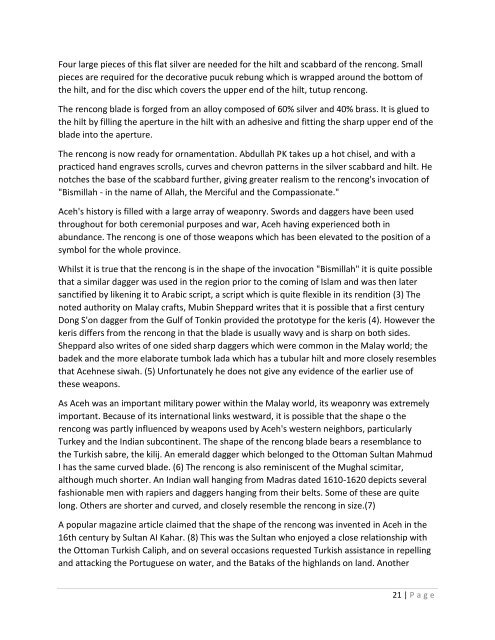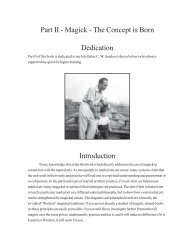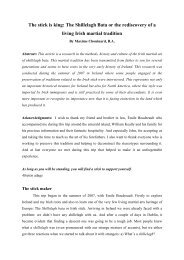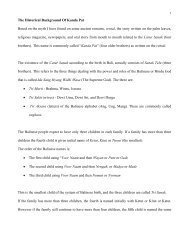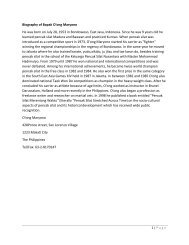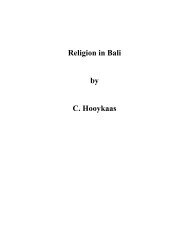The Myth of Maempo Cimande - Pukulan Cimande Pusaka
The Myth of Maempo Cimande - Pukulan Cimande Pusaka
The Myth of Maempo Cimande - Pukulan Cimande Pusaka
Create successful ePaper yourself
Turn your PDF publications into a flip-book with our unique Google optimized e-Paper software.
Four large pieces <strong>of</strong> this flat silver are needed for the hilt and scabbard <strong>of</strong> the rencong. Small<br />
pieces are required for the decorative pucuk rebung which is wrapped around the bottom <strong>of</strong><br />
the hilt, and for the disc which covers the upper end <strong>of</strong> the hilt, tutup rencong.<br />
<strong>The</strong> rencong blade is forged from an alloy composed <strong>of</strong> 60% silver and 40% brass. It is glued to<br />
the hilt by filling the aperture in the hilt with an adhesive and fitting the sharp upper end <strong>of</strong> the<br />
blade into the aperture.<br />
<strong>The</strong> rencong is now ready for ornamentation. Abdullah PK takes up a hot chisel, and with a<br />
practiced hand engraves scrolls, curves and chevron patterns in the silver scabbard and hilt. He<br />
notches the base <strong>of</strong> the scabbard further, giving greater realism to the rencong's invocation <strong>of</strong><br />
"Bismillah - in the name <strong>of</strong> Allah, the Merciful and the Compassionate."<br />
Aceh's history is filled with a large array <strong>of</strong> weaponry. Swords and daggers have been used<br />
throughout for both ceremonial purposes and war, Aceh having experienced both in<br />
abundance. <strong>The</strong> rencong is one <strong>of</strong> those weapons which has been elevated to the position <strong>of</strong> a<br />
symbol for the whole province.<br />
Whilst it is true that the rencong is in the shape <strong>of</strong> the invocation "Bismillah" it is quite possible<br />
that a similar dagger was used in the region prior to the coming <strong>of</strong> Islam and was then later<br />
sanctified by likening it to Arabic script, a script which is quite flexible in its rendition (3) <strong>The</strong><br />
noted authority on Malay crafts, Mubin Sheppard writes that it is possible that a first century<br />
Dong S'on dagger from the Gulf <strong>of</strong> Tonkin provided the prototype for the keris (4). However the<br />
keris differs from the rencong in that the blade is usually wavy and is sharp on both sides.<br />
Sheppard also writes <strong>of</strong> one sided sharp daggers which were common in the Malay world; the<br />
badek and the more elaborate tumbok lada which has a tubular hilt and more closely resembles<br />
that Acehnese siwah. (5) Unfortunately he does not give any evidence <strong>of</strong> the earlier use <strong>of</strong><br />
these weapons.<br />
As Aceh was an important military power within the Malay world, its weaponry was extremely<br />
important. Because <strong>of</strong> its international links westward, it is possible that the shape o the<br />
rencong was partly influenced by weapons used by Aceh's western neighbors, particularly<br />
Turkey and the Indian subcontinent. <strong>The</strong> shape <strong>of</strong> the rencong blade bears a resemblance to<br />
the Turkish sabre, the kilij. An emerald dagger which belonged to the Ottoman Sultan Mahmud<br />
I has the same curved blade. (6) <strong>The</strong> rencong is also reminiscent <strong>of</strong> the Mughal scimitar,<br />
although much shorter. An Indian wall hanging from Madras dated 1610-1620 depicts several<br />
fashionable men with rapiers and daggers hanging from their belts. Some <strong>of</strong> these are quite<br />
long. Others are shorter and curved, and closely resemble the rencong in size.(7)<br />
A popular magazine article claimed that the shape <strong>of</strong> the rencong was invented in Aceh in the<br />
16th century by Sultan AI Kahar. (8) This was the Sultan who enjoyed a close relationship with<br />
the Ottoman Turkish Caliph, and on several occasions requested Turkish assistance in repelling<br />
and attacking the Portuguese on water, and the Bataks <strong>of</strong> the highlands on land. Another<br />
21 | P a g e


